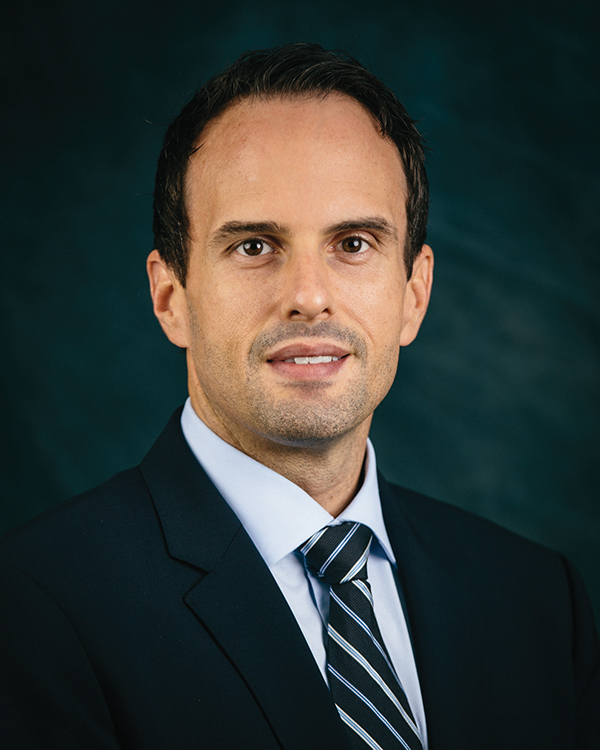Hospitals Expand Spine Care Efficiencies for Patients & Geographic Reach Through Spine Centers of Excellence

In his practice at Scripps Green Hospital in La Jolla, California, orthopedic spine surgeon James Bruffey, M.D., sees a variety of patients, from triathletes to retirees, who suffer from debilitating back pain. Though each case comes with its own complexities, his patients share a common desire: to return to their active lifestyles as soon as possible.
That goal is achieved for a greater number of patients thanks to Scripps Green Hospital’s designation as a Spine Center of Excellence (COE) and its staff of highly skilled surgeons like Bruffey.
“Pursuing this designation has created an initiative for us to look at our processes and make them more efficient and effective,” explains Bruffey, who serves as medical director for Scripps Health’s spine care service line. He is also a HealthTrust Physician Advisor. “If hospitals don’t start refining their spine care guidelines, they’re eventually going to lose access to these patients, because payers will be sending them to facilities that perform better spine care and do so more efficiently.”
With the prevalence of chronic back pain increasing among Americans, the demand for spine surgery is growing. Back pain affects nearly 31 million people, with up to 80% of the population experiencing it at some point in their lives, according to the National Institute of Health’s (NIH) National Institute on Neurological Disorders and Stroke. Back pain is also the most common cause of job-related disability and a leading contributor to missed work days, the NIH notes.
The number of reported cases will likely accelerate even more as baby boomers—who tend to be more physically active than previous generations—age. Back pain is difficult and expensive to treat, costing up to $87 billion annually, according to a 2016 analysis by the Journal of the American Medical Association (JAMA). Though the technology and techniques used in spine surgery have improved, the cost of implants and other medical devices for these procedures has become more expensive, partly due to competition between manufacturers looking to bring new and innovative products to market.
Payer Scrutiny
Despite the rise in spine surgeries, especially among patients in their 40s and 50s, payers are scrutinizing these procedures more than ever. In today’s value-based care landscape, payers often require patients to exhaust all nonsurgical options before considering surgery. This trend is prompting some hospitals to create a comprehensive spine care program that provides a suite of services to help patients combat chronic back pain. These programs may offer everything from conservative treatments such as physical therapy, pain management and nutritional counseling to diagnostics, imaging and injections, in addition to surgery and postoperative care and therapies.
“Some of our less-invasive techniques are actually better at treating several of the conditions patients have, and they still get the best care and a faster recovery,” Bruffey says.
The shift toward value-based care has also triggered providers to engage in bundled payment initiatives designed to reduce costs and improve outcomes. Many larger employers are purchasing bundled care packages for employees directly through selected providers to avoid disparities in quality and pricing across healthcare systems for the same surgeries. These episodic bundles cover the cost of care from start to finish—including all of the procedures, devices, tests, drugs and services a patient will need for a particular surgery. (See sidebar for more on how employers are cutting down on costs.)
Increasingly, the Centers for Medicare and Medicaid Services (CMS), as well as many private health plans, are encouraging and even requiring patients to seek orthopedic care at COEs to obtain reimbursement for services or receive full coverage.

Spine surgery is especially COE-friendly because these surgeries are typically elective and can vary tremendously in their costs and complication rates. Being designated as a COE not only brings hospitals recognition as a local, regional or even national spine care leader, but it also helps them stand out from competitors in a crowded, consumer-driven market. For many patients, surgery is a scary prospect, and they want assurance that the hospital they choose adheres to the highest standards of safety and has a strong track record of positive results, explains Brent Ford, former clinical director, HealthTrust inSight Advisory–Medical Device Management.
“A COE designation conveys that a facility is committed to high-quality, efficient care,” Ford says. “This is attractive to payers, physicians and, most importantly, to patients.”
Perks of Spine Surgery Certification
• Demonstrates commitment to a higher standard of service
• Offers a framework for organizational structure and management
• Provides a competitive edge in the marketplace
• Enhances staff recruitment and development
• Recognized by insurers and other third parties
Source: The Joint Commission
The Joint Commission Certification
Generally defined as specialized programs that provide high concentrations of expertise and focused resources, COEs have no standardized requirements or governing body, which make the criteria for establishing one subjective. In joint replacement surgery, outcomes are routinely measured and tied to Medicare reimbursement. In spine surgery, however, Ford explains that outcomes are less likely to be captured and harder to quantify.
This is where certifications can help. The Joint Commission certifies spine surgery under certifications for its orthopedic programs. Procedures such as discectomy, laminectomy and spinal fusion surgeries are accredited under the standards for Disease-Specific Care (DSC) Certification programs. Though not specific to spine surgery, these standards create an overall framework for how hospitals should manage conditions requiring these surgeries.
To certify these procedures, hospitals must demonstrate:
• Compliance with consensus-based national standards
• Effective and consistent use of appropriate, evidence-based clinical practice guidelines for patient populations requiring these procedures
• Collection and analysis of a minimum of four performance measures specific to the spinal surgery patient population. (At least two of these must be clinical in nature.)
The Joint Commission awards hospitals that comply with these standards a two-year certification. At the end of the first year, they must demonstrate continued compliance and detail how they are working to improve performance. Certifications must be renewed every two years and are contingent upon a favorable on-site review by the The Joint Commission.
Insurance companies also designate spine programs that meet their criteria as COEs, though benchmarks vary by payer. In addition to its Joint Commission certification, Scripps Green Hospital is designated as a COE for Blue Cross Blue Shield, along with Scripps Mercy Hospital in San Diego. Surgeons in these facilities had already been tracking the metrics these payers were looking for—including outcomes, readmission rates, length of stay and cost per case—before ever pursuing the designations.
“We didn’t have to change much,” Bruffey says. “We took the data and processes we had in place and applied those to what each payer was looking for.”
Several Scripps Health surgeons, including Bruffey, also participate in COE programs sponsored by Carrum Health and the Pacific Business Group on Health (PBGH), which help self-insured employers connect with value-based providers.
“They came to us because our programs already fit their model,” Bruffey explains. “Since developing partnerships with these groups, patients have started to come into our system that we would have never seen otherwise.”
Being known as a COE for spine surgery has also helped Scripps Health expand its geographic reach outside of the San Diego-area to southern California and beyond. Patients are triaged through a full-time care coordinator who refers them to the appropriate surgeon and collects all of the information and records needed for reviewing their case.
“At that point, we can almost do telemedicine,” Bruffey says. “I have everything in front of me during phone consults with patients: their images, evaluations, treatments and all of the non-operative care that’s been done, as well as their surgical options. Once a patient meets the criteria for surgery, we can rapidly assess whether it’s appropriate or not and discuss the best route from there.”
More Employees Traveling to COEs for Spine Surgery
To cut back on healthcare spending for expensive spine surgeries, many large, self-insured employers such as GE, Boeing, Lowe’s and Walmart are encouraging employees with chronic back pain to travel to Spine Centers of Excellence for treatment. While employers aren’t necessarily footing the bill themselves, many are partnering with payers to pay surgical and travel expenses for employees who take them up on the offer. Those who choose to stay closer to home for surgery, however, are required to assume all of the out-of-pocket costs for their procedures and postoperative care.
Benefits to the COE travel strategy include:
• Lower bundled care costs for payers
• Fewer complications for patients
• Fewer unnecessary procedures, as up to 50% of patients recommended for surgery might not actually need it
• More efficient and cost-effective care for employees
Scripps Health also provides postoperative care for patients, including out-of-town patients whose travel and lodging arrangements are often covered by their health plans. Maintaining consistency in cost, care and outcomes is the key to successfully operating a COE and keeping that status, Bruffey adds. It’s not unusual for payers to revise their criteria or ask for different metrics, so hospitals must be prepared to meet those requests.
“It helps to designate someone on the administrative side of the hospital who can work with payers and employers to understand what they are looking for and then collaborate with surgeons to come up with a framework that is mutually beneficial for them,” Bruffey says.
Physicians Key to Credibility
Having a seasoned and respected team of surgeons on board is a must for any hospital pursuing a COE designation. Without the expertise and outcomes data these physicians have amassed over the course of their careers, hospitals will likely lack the credentials they need to earn a COE designation and Joint Commission certification.
“Each of the surgeons who are part of our COE programs have been performing surgery here for at least a decade and have a consistent breadth and volume of cases that have produced measurable outcomes,” Bruffey explains.
Hospitals that want to establish a COE must first be willing to provide the space and resources surgeons need, and also involve them in its design. At Scripps Health, spine surgeons meet once a month to discuss everything from pricing and protocols to new techniques and implants they want to explore. This helps ensure a consensus across the system while also encouraging innovation.
“If there is a vendor with a new implant that could help improve outcomes, we all evaluate it, then place it into our formulary to make sure it’s appropriately priced and provides the value everyone is looking for,” Bruffey says.
Orthopedic leaders at Scripps Health hope to add more COE designations to their roster of hospitals in the next few years.
“A COE designation increases Scripps’ exposure on the national stage,” Bruffey adds. “And if we can draw patients across the country to our hospitals for excellence in spine care, it’s going to generate more local interest in these programs as well.”
Though hospitals can profit from the prestige and visibility COE designations bring, patients are the ultimate beneficiaries.
“Improving standardization in costs and outcomes and working to consistently make them better is always good for patients,” Bruffey says.
Share Email Centers of Excellence, Patient Experience, Q3 2019, Surgery




